Sha W., Malinov S. Titanium Alloys: Modelling of Microstructure, Properties and Applications
Подождите немного. Документ загружается.

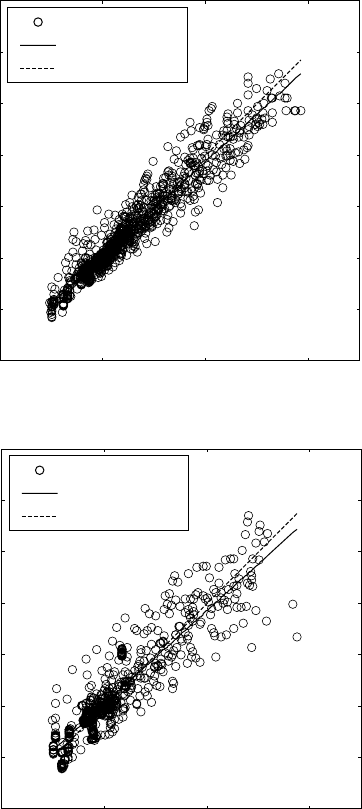
Nitriding: modelling of hardness profiles and the kinetics 503
outputs (which in this case are the microhardness profiles), but it does not
model directly and does not involve and explain the metallurgical changes
and formations in the surface layers during nitriding causing the increase in
microhardness.
18.4
Microhardness values predicted from the second neural network
model versus experimental microhardness for (a) the training,
(b) test and (c) the whole dataset.
Data points
Best linear fit
A = T
R = 0.962
0 400 800 1200
(T) Experimental microhardness (HK)
(a)
(A) Neural network simulations (HK)
1400
1200
1000
800
600
400
200
0
Data points
Best linear fit
A = T
R = 0.911
0 400 800 1200
(T) Experimental microhardness (HK)
(b)
(A) Neural network simulations (HK)
1400
1200
1000
800
600
400
200
0
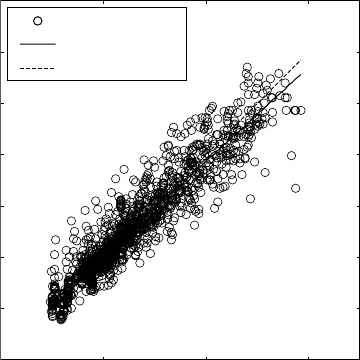
Titanium alloys: modelling of microstructure504
The two models can be used to predict microhardness profiles of titanium
alloys with sufficient accuracy after gas or plasma nitriding at temperatures
between 700 and 1100 °C for periods of time in the range of 1–100 hours.
Data within these ranges are used to train the models. Some microhardness
profiles after gas and plasma nitriding under different conditions are predicted
by the two models in this section. The influence of the basic processing
parameters and the alloy compositions is discussed and analysed.
The time of nitriding is an important processing parameter so its effect is
shown in Fig. 18.6. The outcome from the models is quite similar. With the
increase of the time, there is an increase of the microhardness near the
surface and at the same time an increase of the thickness of the nitrided layer.
These predictions of the NNs are in agreement with what is expected from
the fundamental diffusion theory. The formation of the nitrided layers is a
diffusion process in which the nitrogen diffuses into the substrate. Hence,
there is a deeper penetration of nitrogen as well as a higher concentration of
nitrogen in the nitrided layer after a longer saturation time. This leads to an
effective production of thicker nitrided layers with higher values of
microhardness.
The effect of the temperature on the microhardness and the depth of the
nitrided layers can also be revealed from the trained NNs. Some predictions
of microhardness profiles are shown in Fig. 18.7. The higher temperature of
nitriding causes, in general, an increase in the thickness of the nitrided layer
and an increase in the microhardness of the surface compound layer that is
18.4
Continued
Data points
Best linear fit
A = T
R = 0.943
0 400 800 1200
(T) Experimental microhardness (HK)
(c)
(A) Neural network simulations (HK)
1400
1200
1000
800
600
400
200
0
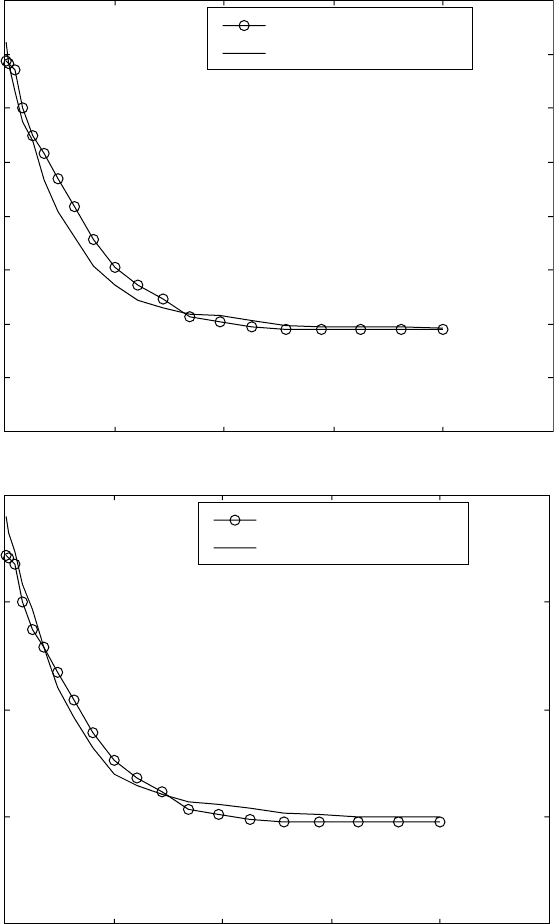
Nitriding: modelling of hardness profiles and the kinetics 505
Experimental
NN prediction (I model)
0 100 200 300 400 500
Distance from the surface (µm)
(a)
HK
1000
900
800
700
600
500
400
300
200
Experimental
NN prediction (II model)
0 100 200 300 400 500
Distance from the surface (µm)
(b)
HK
1000
800
600
400
200
18.5
Comparison between experimental microhardness profiles and
those predicted from the neural network models for: (a) and (b) Ti-
15Mo-5Zr-3Al, gas nitrided in pure N
2
at 750 °C for 60 hours and
(c) and (d) Ti-8Al-1Mo-1V gas nitrided in pure N
2
at 850 °C for
5 hours. The predictions in (a) and (c) are made by the first model
and in (b) and (d) by the second model.
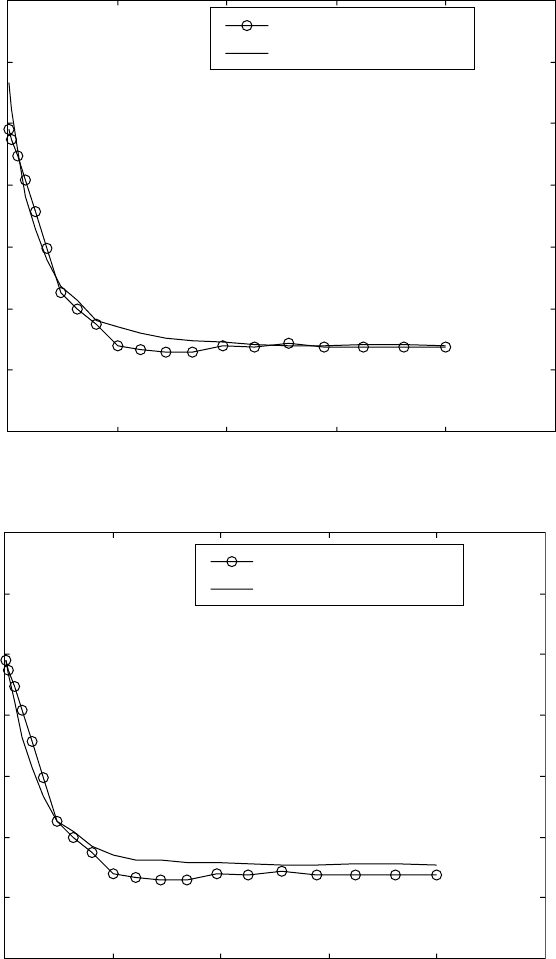
Titanium alloys: modelling of microstructure506
Experimental
NN prediction (I model)
0 100 200 300 400 500
Distance from the surface (µm)
(c)
HK
900
800
700
600
500
400
300
200
Experimental
NN prediction (II model)
0 100 200 300 400 500
Distance from the surface (µm)
(d)
HK
900
800
700
600
500
400
300
200
18.5
Continued

Nitriding: modelling of hardness profiles and the kinetics 507
18.6
Neural network predictions of microhardness profiles for Ti-6Al-
2Sn-4Zr-2Mo, gas nitrided at 900 °C for different periods of time.
Predictions with (a) the first and (b) the second model.
0 100 200 300 400 500
Distance from the surface (µm)
(a)
HK
1000
900
800
700
600
500
400
300
0 100 200 300 400 500
Distance from the surface (µm)
(b)
HK
1000
900
800
700
600
500
400
300
1 h
3 hrs
5 hrs
10 hrs
1 h
3 hrs
5 hrs
10 hrs
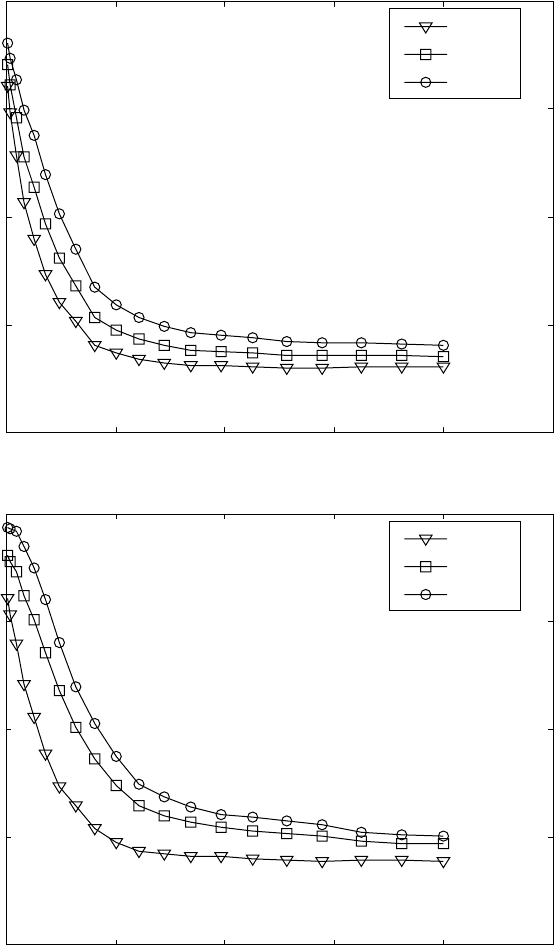
Titanium alloys: modelling of microstructure508
0 100 200 300 400 500
Distance from the surface (µm)
(a)
HK
1000
800
600
400
200
0 100 200 300 400 500
Distance from the surface (µm)
(b)
HK
850 °C
900 °C
950 °C
850 °C
900 °C
950 °C
1000
800
600
400
200
18.7
Neural network predictions of microhardness profiles of Ti-8Al-
1Mo-1V, gas nitrided for 10 hours at different temperatures.
Predictions with (a) the first and (b) the second model.
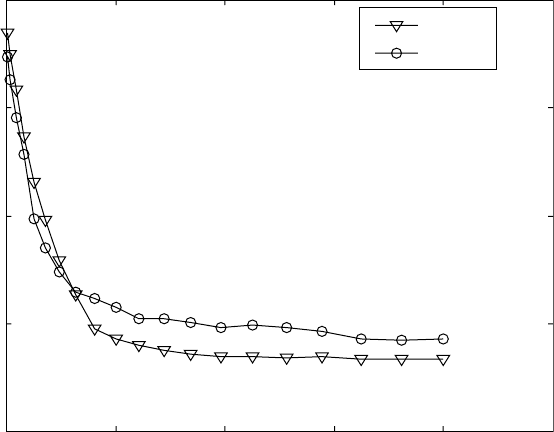
Nitriding: modelling of hardness profiles and the kinetics 509
in agreement with the results predicted from the NN models. The influence
of the nitriding temperature has been studied in Chapters 16 and 17 and by
Galliano et al. (2001). The effect of the layer thickness increases with the
increase of temperature due to the higher diffusion coefficient at higher
temperatures of nitriding. Figures 18.6 and 18.7 also show that the inclusion
of plasma nitriding and gas mixture as inputs (Model 1), although limited
data are available for these, does not worsen the predictions for the influence
of the temperature and the time of nitriding using the model (Model 1) where
these are not used for inputs.
The gas mixture is another processing parameter in nitriding for determining
the characteristics of the nitrided layers. The experimental data for the influence
of the gas mixtures on the surface properties during plasma and gas nitriding
of titanium alloys in the literature are quite limited, so the results from the
NNs such as those shown in Fig. 18.8, need to be proved with further
experimental work.
Another significant process parameter is the alloy composition. The
optimisation of the alloy composition in order to achieve the desirable
microhardness profiles after nitriding is another possibility for using the
model. The effect of the most commonly used alloying elements for titanium
0 100 200 300 400 500
Distance from the surface (µm)
HK
1000
800
600
400
200
pure N
2
95N
2
-5H
2
18.8
Neural network predictions of microhardness profiles of Ti-6Al-
2Sn-4Zr-2Mo, plasma nitrided at 850 °C for 8 hours using pure N
2
and a gas mixture of 95N
2
-5H
2
.
Titanium alloys: modelling of microstructure510
alloys can be studied, but there is not enough information in the literature in
this direction. Nevertheless, an example can be given for the influence of the
alloying elements on the microhardness profiles as their concentration is
varied. Aluminium is probably the most widely used alloying element in
titanium alloys and it exists in the vast majority of the cases in the dataset.
Using the first model, microhardness profiles are obtained after gas and
plasma nitriding changing the aluminium concentration (Fig. 18.9). There is
increase of the microhardness with the increase of the element concentration
after gas nitriding. The tendency for plasma nitriding is similar. Next, we
check the influence of a less common (compared to aluminium) alloying
element such as molybdenum on the microhardness profiles.
There are only four molybdenum-containing alloys in the entire dataset
and all the cases are for gas nitriding in pure N
2
. Therefore, the results for
plasma nitriding of these alloys might not be accurate but anyhow we plot
microhardness profiles predicted from the first model for gas and plasma
nitriding to compare them (Fig. 18.10). From the cases containing molybdenum
(all for gas nitriding in pure N
2
), the model has learned to predict that the
increase of molybdenum would result in an increase of hardness and thickness
of the nitrided layer after gas nitriding (Fig. 18.10a). The same tendency has
been directly transferred to the process of plasma nitriding (Fig. 18.10b),
although such data do not exist in the dataset. Although reasonable, this
tendency needs further experimental verification.
18.1.3 Summary
The correlation between the processing parameters of nitriding and the hardness
of titanium alloys is important. Neural network modelling is a very powerful
and useful modelling technique for modelling of the materials properties and
characteristics. Two neural network models for the simulation and prediction
of microhardness profiles of titanium alloys after gas and plasma nitriding
are developed and described in this section. After training the models, they
show a very good performance, using type, or method, of nitriding, temperature
and time of nitriding, gas atmosphere mixtures and alloy chemical composition
as input parameters for the first model. The second one has a smaller scale,
using temperature and time of nitriding and alloy composition as input
parameters. The NN models, created using experimental data in Chapter 17
as well as those collected from the published literature, can simulate and
predict microhardness profiles after gas and plasma nitriding. Using MatLab,
a microhardness profile can be easily obtained for any combination of input
parameters.
The neural network models are used for the prediction of microhardness
profiles for some real cases of gas and plasma nitrided titanium alloys, which
are in good agreement with the experimental results. The models can be used
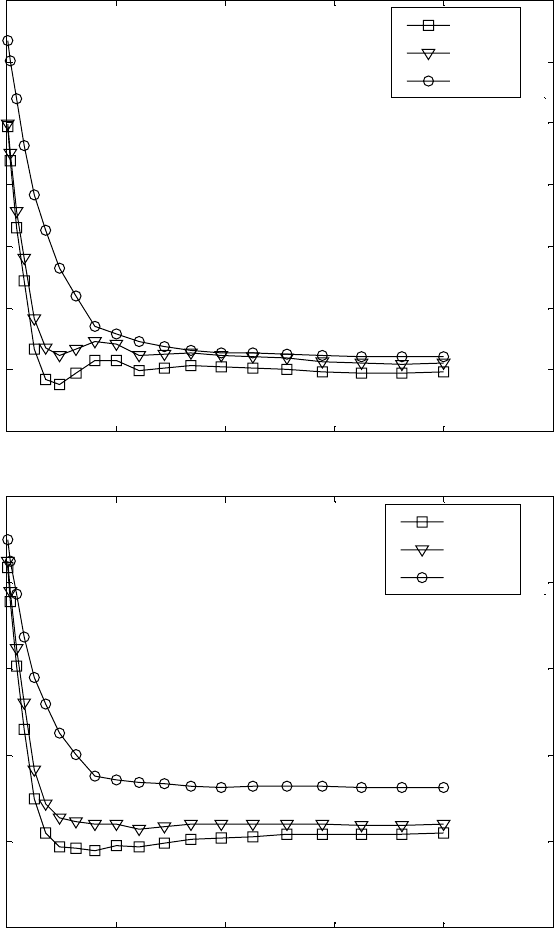
Nitriding: modelling of hardness profiles and the kinetics 511
0 100 200 300 400 500
Distance from the surface (µm)
(a)
HK
900
800
700
600
500
400
300
200
0 100 200 300 400 500
Distance from the surface (µm)
(b)
HK
1000
800
600
400
200
0
0% Al
3% Al
6% Al
0% Al
3% Al
6% Al
18.9
Neural network predictions of microhardness profiles for
titanium alloy with composition Sn = 1.93 wt.%, Zr = 3.97 wt.%, Mo =
1.95wt.%, Fe = 0.07 wt.%, Si = 0.11 wt.% and different Al contents
after (a) gas nitriding and (b) plasma nitriding at 900 °C for 4 hours.
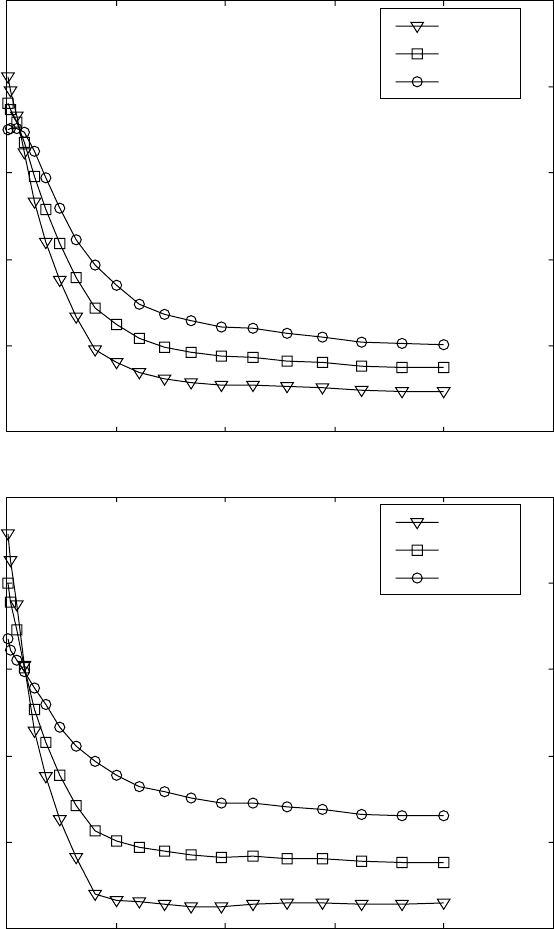
Titanium alloys: modelling of microstructure512
0% Mo
1% Mo
2% Mo
0 100 200 300 400 500
Distance from the surface (µm)
(a)
HK
1200
1000
800
600
400
200
0 100 200 300 400 500
Distance from the surface (µm)
(b)
HK
1200
1000
800
600
400
200
0% Mo
1% Mo
2% Mo
18.10
Neural network predictions of microhardness profiles for
titanium alloy with composition Al = 6.13 wt.%, Sn = 1.93 wt.%, Zr =
3.97 wt.%, Fe = 0.07 wt.%, Si = 0.11 wt.% and different Mo contents
after (a) gas nitriding and (b) plasma nitriding at 950 °C for 5 hours.
